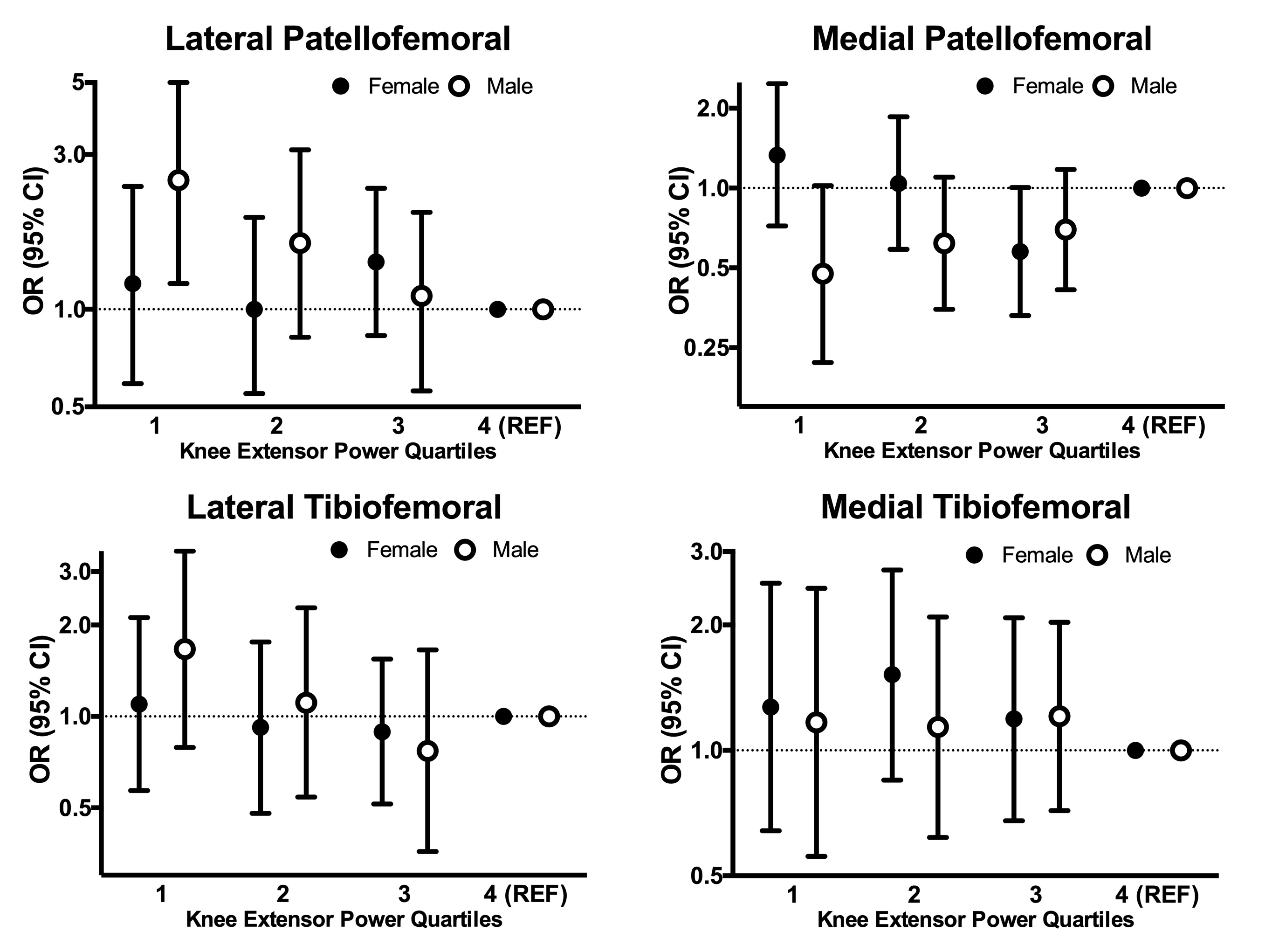Session Information
Session Type: Poster Session A
Session Time: 8:30AM-10:30AM
Background/Purpose: The relation between knee extensor muscle weakness and osteoarthritis (OA) outcomes has been well-studied. Muscle power, another measure of knee extensor function, however, has been less studied in the context of knee OA. Power is the rate at which a load is moved. Velocity of muscle contraction declines with aging, leading to a more precipitous drop in muscular power than in strength and increases vulnerability to joint injury with minor perturbations. Greater knowledge of the extent to which knee extensor power is a risk factor for worsening structure is clinically important, as muscle power is a potentially modifiable risk factor. Identifying relationships between power and structural change may affect current rehabilitation approaches to manage knee OA by shifting the focus from increasing strength to increasing velocity. Thus, our objective was to determine the relation of knee extensor power to worsening cartilage damage in the knee.
Methods: Knee extensor power was assessed using a HUMAC Norm dynamometer. An isotonic knee extension one repetition maximum (1RM) was first determined. Then participants extended each knee as fast and as hard as they could while moving 40% of the 1RM load. Three trials were performed, and the maximum value in Watts was used in the analyses. Knee extensor power was divided into quartiles. Cartilage damage was assessed using the MRI Osteoarthritis Knee Score (MOAKS) by two musculoskeletal radiologists in 14 subregions of the knee at the 144- and 168-month study visits. Worsening cartilage damage was defined as any increase in score, either in size or depth, over 2 years. Analyses were performed separately for the medial/lateral patellofemoral joints (PFJ) and medial/lateral tibiofemoral joints (TFJ). Our unit of analysis was the subregion (e.g., the lateral patellofemoral joint analyses included the lateral patella and lateral anterior femur subregions). Logistic regression with GEE was used to determine the relation of knee extensor power quartiles to any worsening of cartilage damage adjusting for age, BMI, race, and previous knee injury/surgery. Analyses were performed in women and men separately.
Results: 1547 participants were included in the current analysis; mean age and BMI were 61.0 (9.2) years and 28.6 (4.9) kg/m2, respectively; 56% were female and 84% white. The mean knee extensor power was 2.8 (1.0) and 3.9 (1.3) Watts in women and men, respectively. Cartilage worsening was present in 7.3, 6.9, 4.9, and 4.6% of subregions in the lateral PFJ, medial PFJ, medial TFJ, and lateral TFJ in women, respectively. In men, cartilage worsening was present in 8.2, 8.5, 7.0, and 2.6% of subregions in the lateral PFJ, medial PFJ, medial TFJ, and lateral TFJ, respectively. There was no relation between knee extensor power and cartilage worsening in any knee compartment in women. In men, compared to those in the highest knee extensor power quartile, those in the lowest quartile had 2.5 (1.2, 5.0) and 0.48 (0.22, 1.0) times the odds (95% CI) of cartilage worsening in the lateral and medial PFJ, respectively.
Conclusion: In men, lower knee extensor power was associated with increased odds of cartilage worsening in the lateral PFJ and decreased the odds of medial PFJ cartilage worsening.
To cite this abstract in AMA style:
Stefanik J, Felson D, Lewis C, Rabasa G, Guermazi A, Roemer F, Nevitt M, Lewis C, Segal N. Relation of Knee Extensor Power to Worsening Cartilage Damage in the Knee: The MOST Study [abstract]. Arthritis Rheumatol. 2021; 73 (suppl 9). https://acrabstracts.org/abstract/relation-of-knee-extensor-power-to-worsening-cartilage-damage-in-the-knee-the-most-study/. Accessed .« Back to ACR Convergence 2021
ACR Meeting Abstracts - https://acrabstracts.org/abstract/relation-of-knee-extensor-power-to-worsening-cartilage-damage-in-the-knee-the-most-study/

